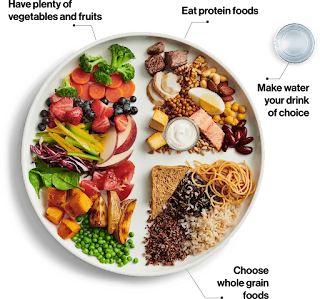New seasons of the year and new seasons
of life require new routines. Even just the need for an extra layer of clothing
or the desire for a warm bowl of soup will shift things. This new season
of life of mine has me working on how to restructure my days. I’m considering new
ways of eating and exercising in addition to a change in my work schedule (and is
this work or pastime, this writing?).
Working on this blog has me
thinking about how to live my best life as an older person. I’m reading all these
articles and social media posts about healthy ageing. I’m worried about losing my mobility and I
want to avoid pain. I want to slow down the trajectory that I’m on and maybe
even change direction.
Food is a good place to start. I started thinking about Omega-3 and I'm now buying more fish, and I’ve added a scheduled fish day to my week. I wrote a post about it. The second way to slow down ageing according to the Shape article that I referenced in my Omega-3 post, is to eat smaller meals more often. So, that’s what I’ll focus on next.
The article says, “Preventing big spikes in insulin can
help minimize cellular harm.”
The idea is that you want to control your insulin levels to prevent the
cellular damage that leads to disease. Like Omega-3 fats, this pattern of
eating is being looked at because it seems to be important at a cellular level,
meaning that the benefits can be numerous. Weight loss and management of
diabetes are the 2 benefits that are mostly listed, but preventing cellular
damage is big. Age-related disease and decline in cognitive function and mobility don't have to be inevitable.
I’ve read other articles about
type-2 diabetes and dieting that suggest that this kind of grazing routine is best for
controlling blood sugar levels, managing hunger, and losing weight. Other
articles aim to prove the opposite, that 2 or 3 meals a day are better.
I think a lot depends on how you
define a meal. I can imagine that someone looking at the plate of food in Canada’s
Food Guide might think
that 2 or 3 of those would be way more than enough, too much food for a day.
That plate is supposed to represent a pie chart of all the kinds foods you
should be eating in a day. I like it better than the pyramid they used to have,
suggesting the number of servings of food groups. This new Food Guide has very
sensible advice on healthy eating habits. It doesn’t say how often or how much
to eat, but recommends being mindful of your eating habits, paying attention to
when you’re hungry and when you’re full. The focus is on what to eat, the
healthy balance of good foods.
Restaurant eating is probably
messing up people’s expectations on what a meal should look like. Portions are
big and meats and starches are highlights- fish and chips, burgers and fries,
spaghetti and meatballs. Maybe it’s a cultural thing?
I don’t like the idea of grazing,
because that sounds like eating all the time and not really paying attention.
Maybe the grazing folks are snacking all day, avoiding meals altogether, not eating with family?
I do think eating smaller meals
at regular intervals makes sense. Maybe we have to adjust our perceptions.
Dinner doesn’t have to be big, and breakfast doesn’t have to be sweet. We don’t
have to eat the whole meal at a restaurant; we can take half the meal to-go, or
share it with a friend (or husband, as my friend Karin does). Our plates and
glasses are too big; let’s use smaller ones.
I can do this. I like the idea of
using smaller plates, and so yesterday I put away a set of large dinner plates
that I had in the cupboard. I’ve already started trying to eat smaller portions.
I don’t know if I can do 5 or 6 meals a day, but I can increase to 4 for now. I’m
worried that if I can’t control my portions, then I will end up eating more by
increasing the number of meals I eat in a day.
The Shape article also recommended not eating after dinner, leaving 10 hours of fasting. And, they mentioned intermittent fasting. I hesitate to go there, as there are fad diets that have controversial ideas about intermittent fasting. Here’s what Wikipedia says about it:
The US National Institute on Aging stated in 2018 that there is insufficient evidence to recommend intermittent fasting, and encourages speaking to one's healthcare provider about the benefits and risks before making any significant changes to one's eating pattern.[13]
Not eating after dinner is fine. I can do that. And, if you want to call the time before breakfast a fast, that’s okay too. That’s something that makes sense to me. I’ve always thought that eating too close to bedtime was not good. So, if we’re not eating for a few hours before going to sleep and we sleep for 8 hours, we’re fasting for 10 or 11 hours right there. I've started walking before breakfast too, so that's another hour sometimes.
This is something I can try to adopt, a new eating routine. I will try to eat smaller meals more often and I will try not to eat or drink after dinner. Cells all over my body will stay healthy and might even rejuvenate. I will continue to be mindful about what and when I eat. I will also take another look at the Canada Food Guide. There was lots of good information there.

Way to go, Sister! That all makes good sense!
ReplyDeleteThank you :-) I will do my best.
ReplyDelete